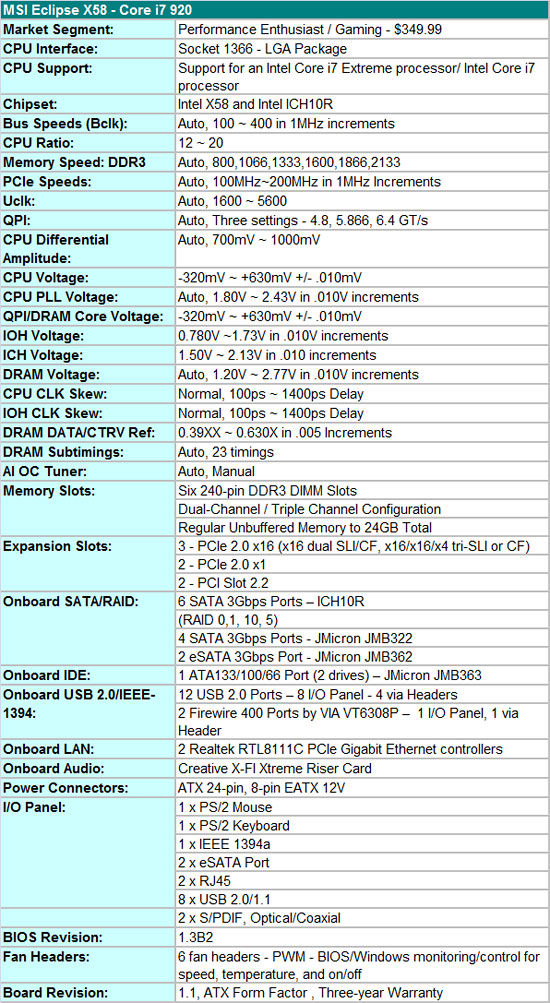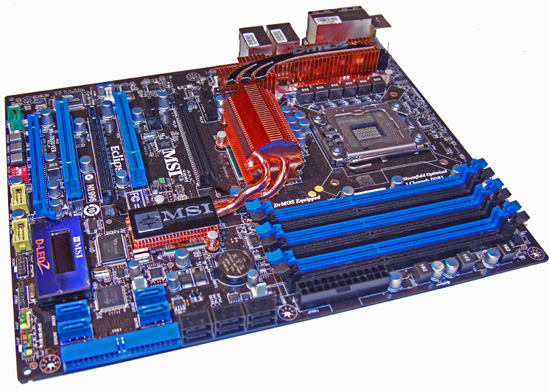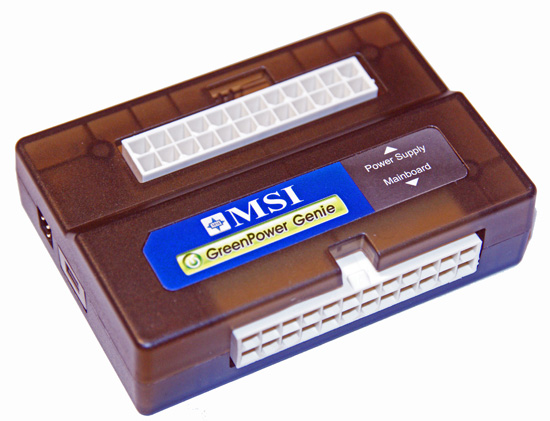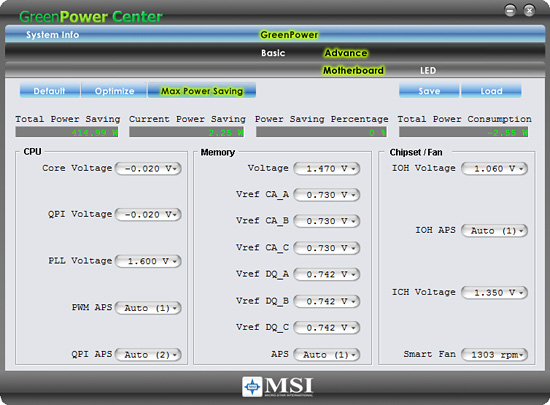Intel X58 Motherboard Roundup - What does $300 Get You?
by Gary Key on December 5, 2008 3:00 PM EST- Posted in
- Motherboards
MSI Eclipse X58
Features

The MSI Eclipse X58 is a feature laden board from a hardware and software viewpoint. It should be considering the $350 price tag, although there is a $30 mail-in-rebate at present. The almost universal Realtek RTL-8111C PCIe Gigabit Ethernet controllers are utilized in tandem; a riser card featuring the Creative Lab's CA0110-IBG chipset provides HD audio and EAX 5.0 capabilities; JMicron’s JMB 363/362/322 chipsets are tabbed for eSATA, IDE, and additional SATA port duties; VIA's VT6308P provides IEEE 1394a support; and the Intel ICH10R is utilized for primary storage purposes.
The BIOS is designed for overclocking duties, although it's not as comprehensive as those from ASUS or Gigabyte. However, it is fair to say that several of the options that ASUS and Gigabyte provide will never be touched by about 95% of us when overclocking. Our main knock against the BIOS is that it is not as user friendly as the others in this roundup. We do not care for the +/- voltage settings as it becomes confusing for the user to understand exactly what effect their changes had on the particular option, especially without knowing what the base voltage is set at.
MSI supports stock memory speeds up to 2133MHz on the i920/i940 processors along with opening up QPI link speeds from a standard 4.800 GT/s up to 6.400 GT/s, which is standard on the i965 Extreme processor. The board fully supports 24GB of DDR3 memory. We have a 24GB kit arriving shortly for testing so we cannot confirm compatibility yet, but we trust MSI in this regard.
In the meantime, we have not had any problems running 12GB with our Patriot or G.Skill DDR3-1600 kits up to 1600 at 9-8-8-24 1T timings, although we needed about 1.68V for absolute stability with the i920 at stock speeds. Dropping the command rate to 2T allows 1.64V operation with the current BIOS. Overall, memory performance is very competitive with the other boards and improving in each BIOS release. However, this is the only six slot board that we have been unable to clock a 12GB configuration up to a 191x21 setting. The board stops around a 175 Bclk with an 8x memory multiplier that results in a DDR3-1528 speed. The board will clock up to a 191 Bclk with the memory multiplier at 6x, which results in a DDR3-1146 setting. MSI is working on improving this area.
The Eclipse board contains three PCI Express 2.0 x16 slots that operate in x16/x16 mode for 2x SLI/CF. The third x16 slot operates in x4 mode regardless of the second slot population. 3x SLI/CF configurations run in x16/x8/x8 mode on the EVGA and Gigabyte boards. We did not notice any performance differences between the x16/x16 or x16/x8 operation in 2x CF with our HD 4870 cards. However, we just received a new BIOS from MSI that allows 3X SLI/CF to operate properly. We will update the article in a few days with a comparison between the boards utilizing all three x16 slots. We had no problems running our ASUS Xonar D2X or Highpoint Rocket RAID cards in slots two or three.
The Board


The Eclipse X58 is MSI's current flagship board with the recently introduced Platinum X58 filling a void in the low end X58 market with a $220 price tag. While $220 is an awful lot for a motherboard, it's practically a bargain in this particular market sector. Of course, you give up a few items like SLI compatibility, an additional x16 slot, and the JMicron SATA ports, but for a lot of users those features are not that important.
MSI went a different direction with this board compared to earlier designs; gone is the roller coaster or circular heatpipe design, as is the traditional fire engine red color scheme that is now a subdued black and blue color palette. While colors do not determine the performance of a board, they do tend to make a difference in first impressions. We like the new color scheme and sincerely appreciate a more traditional heat pipe setup. In fact, MSI skipped on an elaborate heatpipe setup found on other boards and concentrated on cooling the voltage circuitry separately, although the northbridge and southbridge are still linked together.
The CPU area is fairly open and our larger air coolers did not pose a problem. The Eclipse board features a two-phase power delivery system for the northbridge and for the memory subsystem. A six-phase power delivery design is utilized for the processor, half that of the Gigabyte and ASUS boards. However, this did not adversely affect the overclocking capabilities of the board. MSI utilizes high quality solid-state capacitors and ferrite core chokes on the board.
The general layout is very good as MSI has managed to situate the vast number of ports, slots, and hardware in a manner that keeps them from interfering with installed peripherals. MSI managed to squeeze three PCI Express 2.0 x16 slots (x16/x16/x4), two PCIe x1 slots, and two PCI slots. This arrangement allows 3X Crossfire or SLI and still leaves a single PCIe x1 slot open. However, using a double slot card in the third slot will make it extremely difficult to utilize the power, reset, IEEE 1394a, and USB ports. Our opinion about 3X CF/SLI is not that high unless you are benchmarking for 3DMark records, so we appreciate the fact that a 2X CF/SLI arrangement will leave a PCIe x1, PCI, and PCIe x16 (x4 electrical) slot open.
On the bottom of the board you will find onboard buttons for power, reset, and the D-LED 2 display module. The D-LED 2 is handy for a quick glance during the POST process or you can have it display VCore or northbridge voltages along with pinpointing a particular temperature on the board with the included 20" probe. The D-LED does not display hex codes, instead relying on short hand messages like "DDR Ini" during post processes.
While we appreciate the D-LED, it is really only good for windowed cases or open platform testing. We think MSI should have included an attachment cable that allowed placement outside of the case. Also, the unit does not live up to its potential by providing additional hardware monitoring capabilities such as temperatures, fan speeds, or other voltage readings. Of course, MSI has monitoring software that accomplishes these tasks, but we think a hardware solution would be better, especially considering the cost of the board.
The IO panel features eight USB 2.0 ports, two Ethernet jacks, an IEEE 1394a port, and two eSATA ports courtesy of the JMB 362 chipset. MSI also includes an expansion slot backplate that allows an additional two eSATA ports via any of the board's internal SATA connections. An audio output panel is missing since MSI utilizes a riser card that features Creative Lab's CA0110-IBG audio chipset.
Our first reaction was very positive until we looked at the chipset specifications and realized that hardware audio processing capabilities - including the EAX 5.0 implementation - are done through software and the CPU. Also, most of the software features from a standalone X-FI card are not available in the software package that MSI provides. They did include access to Creative's 24-bit Crystalizer and speaker virtualization features along with other hardware settings.
Of course the big question is the audio quality provided by this solution. RightMark Audio Analyzer indicated poor THD and inter-channel leakage, but in actual usage we could not tell any real differences between the Creative and Realtek solutions in music playback quality. The ADI solution on the ASUS board sounded a bit clearer and dynamic in music playback. In gaming, we thought the Creative solution was slightly better than the ADI chipset and noticeably better than the Realtek solutions on the Gigabyte and EVGA boards. If gaming or music playback is a priority, we still suggest an add-in card for best performance.
The Application


MSI features a unique power saving system on the Eclipse. They include a GreenPower Genie pass-through connector that attaches to the 24-pin ATX power supply cable and a cable that attaches to the 24-pin ATX connector on the motherboard. There is also a two-pin cable that attaches to the Genie and the motherboard that works in conjunction with the the GreenPower software to monitor and dynamically reduce power usage.
This system will automatically scale the number of active power phases for the processor, memory, and northbridge. We noticed savings of 9W at idle, so it actually works. In fact, it provides better results than the ASUS EPU-6 or Gigabyte DES power saving systems. During testing, it was able to switch fast enough so we did not have to worry about program crashes when utilizing GreenPower. The one drawback is that the pass-through connector and cable is a bit cumbersome to use in smaller cases.
















78 Comments
View All Comments
mvrx - Wednesday, December 10, 2008 - link
I know these motherboards are months away, but please include dual socket i7 reviews as soon as they become available for testing. My next system will be a dual i7 quad for sure and I'm anxiously awaiting these MB's to come out and mature.I didn't go with current dual socket architectures because of FB-DIMMs limiting the performance and costing so much more. Really hoping to see a resurgance of the dual+ socket enthusiast systems.
And if anyone replies "What can you be using that even takes up a single socket quad core" - well.. then you probably don't know enough about enthusiast computing to reply here. ;-)
strikeback03 - Wednesday, December 10, 2008 - link
I'd think that last line shows why we are unlikely to see a resurgence of multi-socket enthusiast systems. There are very few that have applications which would take advantage of more than 4 physical cores/8 logical cores.mvrx - Thursday, December 11, 2008 - link
Well, I approach it with this logic..... and I get this alot from people.. "few applications that take advantage of more than 4 cores". I'm not running one or two applications....
MS OneCare (or your chosen security suite), seems to zap 15%-20% of overall system performance depending on what it's doing.
Even my old LOTR BFME2 ROTWK game spans 4 cores.. Not very well, but it does.
I run a skype conference server for gamers (an upcoming competitor to Ventrilo) with 20 or so callers on the line at once. Skype (especially skype 4.0) spans many cores reasonably well. (s4pg.us - website's not up yet)
I like to leave my email, web browsers, etc - open when I play my games.. and unfortunately I probably have another 10 active programs sitting in the background in some way. According to resource manager I have about 1100 active threads running, I think the average enthusiast only would have 500-700.
Now, I may be the upper-end of the catagory of heavy resource users, but thats mostly because people don't have the horsepower to do more so they don't. Chicken and Egg issue. If I can get a i7 for $300, and maybe the dual socket MB costs me a $150 premium, I'm sure as heck going to go dual socket.
I know one of my biggest issues is HD performance, but I hope to fix that with one of Micron Tech's new PCIe SSD cards... At that point, I'll probably be easily slamming two i7's. And I do like to run x264 mp4 compression jobs overnight. Even if it only liked using 4 cores, I can run several instances at once.
According to the roadmaps, the X58 is dual socket ready.. So I doubt it will be long until we see at least a few boards.
anindrew - Wednesday, December 10, 2008 - link
I had already ordered and received most of my parts for my new X58/i7 920 based system before this article went up. I was anxiously waiting for it to see what Anand and crew thought. Like so many commented here, I had no idea Anandtech's crew helped sort out issues with motherboards and BIOSes. I think it would be interesting to hear more about that and specifically why you did that (by choice or to help everyone).I built my system yesterday using the Gigabyte GA-EX58-UD5, i7 920, and 6GB of G.Skill DDR3-1600 8-8-8-21 memory (those are the actual specs of it). I have had no problems at all setting the system up. Everything works as it should. I have not tried to overclock yet, but I will since I have the Noctua SE1366.
The Asus P6T does look great, and I am happy to hear that it worked as it should right away. I had to debate between the Asus and Gigabyte boards. In the end, I chose the Gigabyte because I got a $30 discount in a combo with the Geforce GTX260 core 216. Time will tell if I made the right choice. :-)
chuckbam - Tuesday, December 9, 2008 - link
I member of ABXZone.com pointed out to me that the ASUS P6T Deluxe has a memory range conflict on the device I/O APIC controller. Does anyone have more information on this?http://chuckbam.com/Posts/IOAPIC.PNG">http://chuckbam.com/Posts/IOAPIC.PNG
chrhon - Tuesday, December 9, 2008 - link
Thank you for bringing up those comments at the begging of the article. Pretty much everyone I talk to is fed up with motherboard problems and even considering something such as buying from Dell. These mobo manufacturers are shooting themselves in the foot. Sadly the reviews seem to help them.My last build I started with a Gigabyte board and it was good to me but there were complaints on all the reviews on the memory overclocking. Then that board stopped working for me and I bought a DFI board that was universally praised by the reviews and it was the biggest pain in the ass - almost every time I would add or remove a card or flash the BIOS I would go through non-POST hell. I don't see myself EVER buying a DFI board again based on that experience.
If a motherboard company comes out bragging about its quality components and stability THAT is where I am going to put my money. Believe it or not its things like chipset fans being cheap and going out that make more difference in long term satisfaction of a board than one more (when there are already 50) way to tweak some voltages.
Kroneborge - Tuesday, December 9, 2008 - link
Reliability is definitely key. Fast doesn’t matter if your computer won’t run. I do music production, along with my games, and I want a system that is going to run all the time with no problems. If that means I can’t overclock, then I would rather do that. I definitely suggest adding a reliability chart so those of us who need computers for production purposes can factor that in.Also for music production having 12gb or even 24 is perfectly reasonable for large sample libraries. Manufacturers that think supporting those sizes (as advertised) isn’t a priority are wrong.
Thanks for the great review, and please continue to put an emphasis on things working. And keep updating stuff so we know where they stand. I for one won’t be purchasing my new computer till I’m sure I can get it working with little fuss right out of the box.
SiliconDoc - Tuesday, December 9, 2008 - link
That was very kind of you Anand - to point out how the monster that was created is out of control...rofl - I couldn't help thinking - imagining - it's just like the bankers/loan officers/fannie n freddie freaks that fried the economy with wild eyed speculation and housing bubbling... just crazed wackos doing "what must be done" in the name of ... well profits or chest thumping or bonuses or bragging rights or all the above in all cases...
Now the crash and burn of simple motherboard features not even working is splaying out in the public - I've seen the posted reports by the end users...
"We don't have to do it right - or even ethically *advertised features actually work* - seems to be the call of the day everywhere.
So anyway - good job actually EXPERIENCING THE LAST STRAW AND TRYING TO DO SOMETHING ABOUT IT .
Hopefully the pendulum will swing back toward center without anyone getting fragged... (although I'm sure purchasers in some cases wish otherwise).
SiliconDoc - Tuesday, December 9, 2008 - link
PS - Yes, so that I'm not missing something either - it DOES sound like they owe Anand and the staff about a million bucks (each).I can see how a good review here and there has now ballooned into "lab support" ....
A million bucks each ought to do - the manufacturers can take up an R&D collective - if they threaten to cut off boards just do a maniacal laugh - they will crumble and pay up.
;-)
araczynski - Monday, December 8, 2008 - link
mildly interesting, but personally i'd like to see this in comparison to something from the 'normal' lineup, you know, like what most people currently have.throw a C2D/3ghz/4gb in there and then we have something interesting.
compare apples to apples, not just apples to themselves.